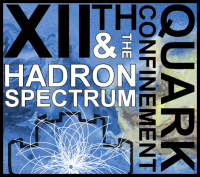Speaker
Description
In the last decade many states in the spectrum of charmonium and bottomonium lying above the open-flavour threshold have been observed experimentally. Most of these states reside in the vicinity of strong thresholds and cannot be described by simple quark models. Description and understanding of such exotic states is a challenge for phenomenology of strong interactions which requires building adequate theoretical tools and approaches. In this work, a practical parametrisation for the line shapes of near threshold resonance(s) is derived in the framework of a coupled-channel model which includes an arbitrary number of elastic and inelastic channels as well as a bare pole term. Parameters of the distribution have a direct relation to phenomenology and the resulting analytical parametrisation is therefore ideally suited to investigate the full
information content provided by the measurements and to establish a link between the experimental data and their theoretical interpretation.
Summary
A practical parametrisation for the line shapes on near-threshold states is derived in the frame work of a coupled-channel model. The power of the suggested approach is demonstrated at the example of the combined data analysis for the Zb(10610) and Zb(10650) states in the spectrum of bottomonium.
